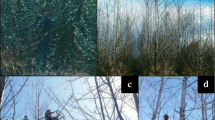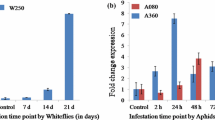Abstract
A protocol has been developed for efficiently transforming and regenerating the hybrid aspenPopulus tremula x P. tremuloides. Stem segments were co-cultivated with a strain ofAgrobacterium tumefaciens carrying a disarmed binary vector conferring resistance to kanamycin or hygromycin. The respective vectors also carried a fused bacterialluxF2 gene expressed from the cauliflower mosaic virus 35S promoter. All transformants had a normal phenotype. Genetic tranformation and stable integration of the heterologous DNA was confirmed by Southern hybridization and luciferase expression. The latter was measured by destructive enzymatic assay throughout the transformatnt and by non-destructive image analysis in leaves left attached to intact plants. Both measurement techniques detected marked within- and between-organ variation in luciferase expression. However, the spatial patterns detected by each technique in the leaves were similar. The results indicate thatin vivo imaging of light emission can be used to measure repeatedly the expression of a promoter-luciferase gene fusion in a particular leaf over an extended time period. It was also demonstrated that enzymatically assayed luciferase activity in leaves was notably lowere in transgenic hybrid aspen plants than in tobacco plants transformed with the same vector. This was not due to a difference in luciferase enzyme activity between the two species, and therefore indicated that the 35S promoter is not as active in hybrid aspen as in tobacco.
Similar content being viewed by others
References
Ahuja, M.R. (1987)In vitro propagation of poplar and aspen. In Bonga, J.M., and Durzan, D.J. eds,Cell and Tissue Culture in Forestry, Vol. 3, pp. 207–23. Dordrecht: Martinus Nijhoff Publishers.
Ahuja, M.R. (1988) Gene transfer in forest trees. In Hanover, J.W. and Keathley, D.E. eds,Genetic Manipulation of Woody Plants, pp. 25–42. New York: Plenum Press.
Benfey, P.N. and Chua, N.H. (1989) Regulated genes in transgenic plants.Science 244, 174–81.
Birnboin, H.C. and Doly, J. (1979) A rapid alkaline extraction procedure for screening recombinant plasmid DNA.Nucl. Acids Res. 7, 1513.
Bradford, M. (1976) A rapid and sensitive method for the quantification of microgram quantities of protein, utilizing the principle of protein-dye binding.Anal. Biochem. 72, 248–51.
Chalupa, V. and Aldén, T. (1988) Control of morphogenesis by cytokinins in tissue culture of forest tree species. In Hällgren, J.E. ed.,Molecular Genetics of Forest Tree Species, Report 8, pp. 201–8. Proc. Kempe Symposium, Swedish Univ. Agric. Sci., Ume⇘, Sweden.
Cheliak, W.M. and Rogers, D.L. (1990) Integrating biotechnology into tree improvement programs.Can J. For. Res. 20, 452–63.
Choi, W.Y., Lee, B.S., Lee, K.J., Chung, H.K., Lee, S.K. and Shim, S.Y. (1988) Gene transfer intoPinus densiflora andQuercus acutissima byAgrobacterium tumefaciens.Res. Rep. Inst. For Gen. Korea 24, 121–6.
Dandekar, A.M., Gupta, P.K., Durzan, D.J. and Knauf, V. (1987) Transformation and foreign gene expression in micropropagated Douglas-fir (Pseudotsuga menziesii).Bio/Technology 5, 587–90.
De Block, M. (1990) Factors influencing the tissue culture and theAgrobacterium tumefaciens-mediated transformation of hybrid aspen and poplar clones.Plant Physiol. 93, 1110–6.
Doyle, J.J. and Doyle, J.L. (1990) Isolation of plant DNA from fresh tissue.Focus 12, 13–5.
Ellis, D., Roberts, D., Sutton, B., Lazaroff, W., Webb, D. and Flinn, B. (1989) Transformation of white spruce and other conifer species byAgrobacterium tumefaciens.Plant Cell Rep. 8, 16–20.
Fillatti, J.A.J., Sellmer, J., McCown, B., Haissig, B. and Comai, L. (1987)Agrobacterium-mediated transformation and regeneration ofPopulus.Mol. Gen. Genet. 206, 192–9.
Fiola, J.A., Hassan, M.A., Swarz, H.J., Bors, R.H. and McNicols, R. (1990) Effects of thidiazuron, light fluence rates and kanamycin inin vitro shoot organogenesis from excisedRubus cotyledons and leaves.Plant Cell Tissue Organ Culture 20, 223–8.
Fromm, M., Taylor, P.L. and Walbot, V. (1985) Expression of genes transferred into monocot and dicot plant cells by electroporation.Proc Natl Acad. Sci. USA 82, 5824–8.
Hood, E.E., Clapham, D.H., Ekberg, I. and Johansson, T. (1990) T-DNA presence and opine production in tumors ofPicea abies (L.) Karst induced byAgrobacterium tumefaciens A281.Plant Mol. Biol. 14, 111–17.
Horsch, R.B., Fry, J.E., Hoffman, N.L., Eicholtz, D., Rogers, S.G. and Fraley, R.T. (1985) A simple and general method for transferring genes into plants.Science 227, 1229–31.
James, D.J., Passey, A.J., Barbara, D.J. and Bevan, M. (1989) Genetic transformation of apple (Malus pumila Mill.) using a disarmed Ti-binary vector.Plant Cell Rep. 7, 658–61.
Jefferson, R.A., Kavanagh, T.A. and Bevan, M.W. (1987) GUS fusions: β-glucuronidase as a sensitive and versatile gene fusion marker in higher plants.EMBO J. 6, 3901–7.
Kerns, H.R. and Meyer, M.M. (1986) Tissue culture propagation ofAcer x freemanii using thidiazuron to stimulate shoot tip proliferation.Hort. Science 21, 1209–10.
Klopfenstein, N.B., Shi, N.Q., Kernan, A., Mcnabb, H.S., Hall, R.B., Hart, E.R. and Thornburg, R.W. (1991) TransgenicPopulus hybrid expresses a wound-inducible potato proteinase inhibitor II-CAT gene fusion.Can. J. For. Res. 21, 1321–8.
Koncz, C. and Schell, J. (1986) The promoter of the TL-DNA gene 5 controls the tissue-specific expression of chimeric genes carried by a novel type ofAgrobacterium binary vector.Mol. Gen. Genet. 204, 383–96.
Koncz, C., Olsson, O., Langridge, W.H.R., Schell, J. and Szalay, A.A. (1987) Expression and assembly of functional bacterial luciferase in plants.Proc. Natl Acad. Sci. USA 84, 131–5.
Koncz, C., Langridge, W.H.R., Olsson, O., Schell, J. and Szalay, A.A. (1990) Bacterial and firefly luciferase genes in transgenic plants: Advantages and disadvantages of a reporter gene.Dev. Gen. 11, 224–32.
Kramer, P.J. and Kozlowski, T.T. (1979)Physiology of Woody Plants. New York: Academic Press.
Langridge, W.H.R., Fitzgerald, K.J., Koncz, C., Schell, J. and Szalay, A.A. (1989) Dual promoter ofAgrobacterium tumefaciens mannopine synthase genes is regulated by plant growth hormones.Proc. Natl Acad. Sci. USA 86, 3219–23.
Lin, W., Odell, J.T. and Schreiner, R.M. (1987) Soybean protoplast culture and direct gene uptake and expression by cultured soybean protoplasts.Plant Physiol. 84, 856–61.
Loopstra, C.A., Stomp, A.M. and Sederoff, R.R. (1990)Agrobacterium-mediated DNA transfer in sugar pine.Plant Mol. Biol. 15, 1–9.
McGranahan, G.H., Leslie, C.A., Uratsu, S.L., Martin, L.A. and Dandekar, A.M. (1988)Agrobacterium-mediated transformation of walnut somatic embryos and regeneration of transgenic plants.Bio/Technology 6, 800–4.
McGranahan, G.H., Leslie, C.A., Uratsu, S.L. and Dandekar, A.M. (1990) Improved efficacy of the walnut somatic embryos gene transfer system.Plant Cell Rep. 8, 512–6.
Mackay, J., Séguin, A. and Lalonde, M. (1988) Genetic transformation of9 in vitro clones ofAlnus andBetula byAgobacterium tumefaciens.Plant Cell Rep. 7, 229–32.
Murashige, T. and Skoog, F. (1962) A revised medium for rapid growth and bioassays with tobacco tissue cultures.Physiol. Plant 15, 473–97.
Odell, J.T., Nagy, F. and Chua, N.H. (1985) Idenficication of DNA sequences required for activity of the cauliflower mosaic 35S promoter.Nature 313, 810–12.
Olsson, O., Koncz, C. and Szalay, A.A. (1988) The use of theluxA gene of the bacterial luciferase operon as a reporter gene.Mol. Gen. Genet. 215, 1–9.
Olsson, O., Escher, A., Sandberg, G., Schell, J., Koncz, C. and Szalay, A.A. (1989) Engineering of monomeric bacterial luciferases by fusion ofluxA andluxB genes ofVibrio harveyi.Gene 81, 335–47.
Olsson, O., Nilsson, O. and Koncz, C. (1990) Novel monomeric luciferase enzymes as tools to study plant gene regulationin vivo.J. Biolumin. Chemilumin. 5, 79–87.
Ou-Lee, T.M., Tugeon, R. and Wu, R. (1986) Expression of a foreign gene linked to either a plant-virus orDrosophila promoter, after electroporation of protoplasts of rice, wheat, and sorghum.Proc. Natl Acad. Sci. USA 83, 6815–9.
Ow, D.W., Wood, K.W., DeLuca, M., DeWet, J.R., Helinski, D.R. and Howell, S.H. (1986) Transient and stable ecpression of the firefly luciferase gene in plant cells and transgenic plants.Science 234, 856–9.
Pang, S.Z. and Sanford, J.C. (1988)Agrobacterium-mediated gene transfer in Papaya.J. Am. Soc. Hort. Sci. 113, 287–91.
Parsons, T.J., Sinkar, V.P., Stettler, R.F., Nester, E.W. and Gordon, M.P. (1986) Transformation of poplar byAgrobacterium tumefaciens.Bio/Technology 4, 533–6.
Pythoud, F., Sinkar, V.P., Nester, E.W. and Gordon, M.P. (1987) Increased virulence ofAgrobacterium rhizogenes conferred by thevir region of pTiBo542: Application to genetic engineering of poplar.Bio/Technology 5, 1323–7.
Russel, J.A. and McCown, B.H. (1988) Recovery of plants from leaf protoplasts of hybrid-poplar and aspen clones.Plant Cell Rep. 7, 59–62.
Sambrook, J., Fritsch, E., and Maniatis, T. (1989)Molecular Cloning, A Laboratory Manual, Second edition. Cold Spring Harbor, New York: Cold Spring Harbor Laboratory.
Schneider, M., Ow, D.W., and Howell, S.H. (1990) Thein vivo pattern of firefly luciferase expression in transgenic plants.Plant Mol. Biol. 14, 935–47.
Schell, J. (1987) Transgenic plants as tools to study the molecular organization of plant genes.Science 237, 1176–83.
Sederoff, R., Stomp, A-M., Chilton, W.S. and Moore, L.W. (1986) Gene transfer into loblolly pine byAgrobacterium tumefaciens.Bio/Technology 4, 647–9.
Stachel, S.E. and Zambryski, P. (1986)virA andvirG control the plant-induced activation of the T-DNA transfer process ofA. tumefaciens.Cell 46, 325–33.
Stachel, S.E., Timmerman, B. and Zambryski, P. (1986a) Generation of single-stranded T-DNA molecules during the initial stages of T-DNA transfer fromAgrobacterium tumefaciens to plant cells.Nature 322, 706–12.
Stachel, S.E., Nester, E.W. and Zambryski, P.C. (1986b) A plant cell factor inducesAgrobacterium tumefaciens vir-gene expression.Proc. Natl. Acad. Sci. USA 83, 379–83.
Stomp, A.M., Loopstra, C., Chilton, W.S., Sederoff, R.R. and Moore, L.W. (1990) Extended host range ofAgrobacterium tumefaciens in the genusPinus.Plant Physiol. 92, 1226–32.
Vahala, T., Stabel, P. and Eriksson, T. (1989) Genetic transformation of willows (Salix spp.) byAgrobacterium tumefaciens.Plant Cell Rep. 8, 55–8.
Van Nieuwkirk, J.P., Zimmerman, R.H. and Fordham, I. (1986) Thidiazuron stimulation of apple shoot proliferationin vitro.Hort. Science 21, 516–8.
Williamson, J.D., Hirsch-Wyncott, M.E., Larkins, B.A. and Gelvin, S.B. (1989) Differential accumulation of a transcript driven by the CaMV 35S pormoter in transgenic tobacco.Plant Physiol. 90, 1570–6.
Author information
Authors and Affiliations
Rights and permissions
About this article
Cite this article
Nilsson, O., Aldén, T., Sitbon, F. et al. Spatial pattern of cauliflower mosaic virus 35S promoter-luciferase expression in transgenic hybrid aspen trees monitored by enzymatic assay and non-destructive imaging. Transgenic Research 1, 209–220 (1992). https://doi.org/10.1007/BF02524751
Received:
Revised:
Accepted:
Issue Date:
DOI: https://doi.org/10.1007/BF02524751




